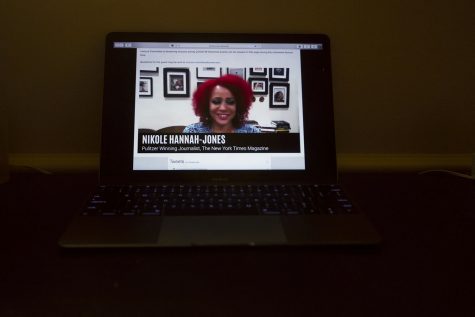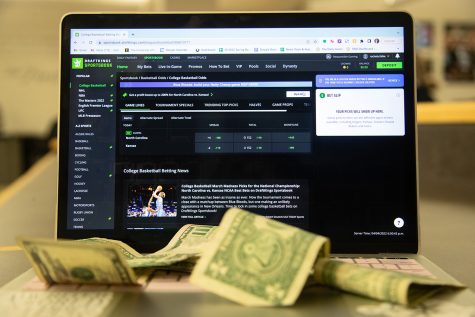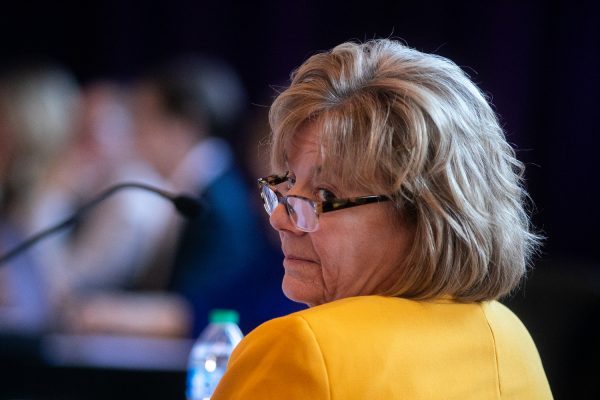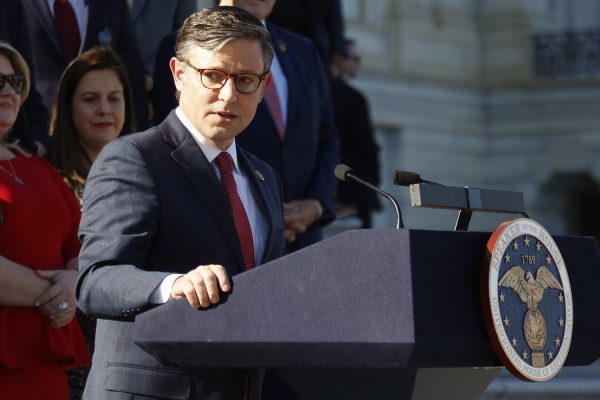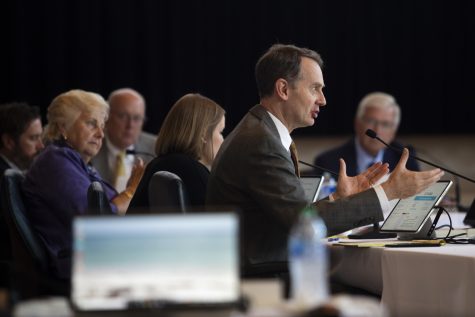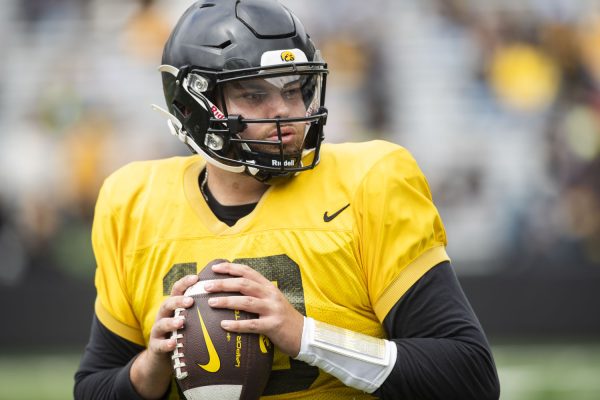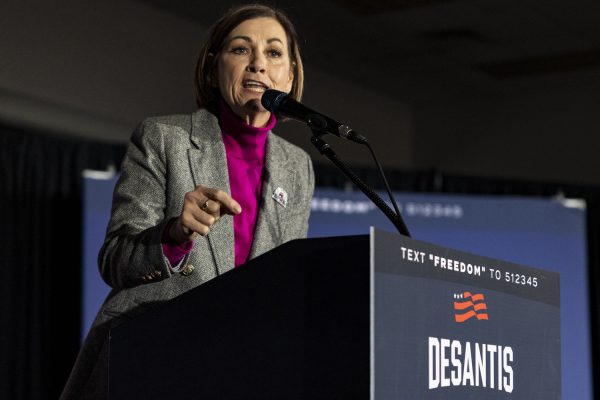‘I feel completely disregarded as a pawn in the partisan politics at the Statehouse’: Educators respond to in-person learning requirements
All school districts in Iowa will need to offer a fully in-person option by Feb. 15 according to a bill passed by the Iowa legislation. Some educators are frustrated by a lack of local control for the districts.
STEM teacher Bennett Brown recently resigned from teaching at Iowa City Southeast Junior High School because of state legislation requiring an in-person option learning starting February 15. Brown stands outside of Southeast Junior High School on February 13, 2021.
February 14, 2021
After more than two decades in education, Iowa City teacher Bennett Brown found himself at a crossroads when state legislation requiring a fully in-person option for schooling was signed on Jan. 29.
On the same day, Brown, a computer-science teacher at Southeast Junior High, offered the district his resignation to take a stance against the legislation because he believes it threatens public safety. He began his teaching career in 1992 and has taught for five years at the school.
He said Iowa City schools have done everything they can to keep people safe and maximize learning outcomes, but Iowa Gov. Kim Reynolds and the Legislature are making it difficult.
Brown accepted a position at a startup where he will be involved with engineering education in universities across the country. Brown will finish out teaching this trimester, which ends on March 9.
“We know which kids need extra attention, which kids need enrichment, which kids need to be in person, and we work with families to use resources the most effectively, but the governor is making that impossible to do safely,” he said.
Brown said he isn’t making this decision to resign out of fear of his own safety, but fear that public health is at risk. He said there was already an instance during the school’s hybrid learning schedule of a child in one of his classes who gave COVID-19 to the student sitting next to them, and then went home and gave it to their family.
The Iowa City Community School District allowed students to enroll in a fully online or hybrid learning model at the beginning of the school year. Brown has spent the majority of this school year teaching two sections of online learning and one section of hybrid learning. When Reynolds signed a bill to require in-person learning, however, the district had to do away with the hybrid option.
“We do not have the teachers or the space to run three different models of education,” said Lisa Williams, an Iowa City school board member. “So, we can’t do a full onsite, a hybrid, and an online program with the resources that we have, so we had to get rid of the hybrid options and eliminate that as a choice.”
The bill was introduced Jan. 20, eight days after Reynolds asked lawmakers during her Condition of the State address to send her a bill as soon as possible requiring schools to offer an all in-person option. On Jan. 28, it passed in the Senate 29-18 along party lines and in the House 59-39, with Rep. Wes Breckenridge, D-Newton, voting with Republicans.
This law requires Iowa’s public school districts and accredited non-public schools to provide parents and guardians with a fully in-person instruction option. Today was the deadline for schools to begin offering all in-person instruction, and the bill is effective through June 30.
Williams said the new law is taking away parent choice because many families were comfortable with the hybrid option. With the elimination of the hybrid option, the district cannot guarantee they have the space and resources to continue the same mitigation efforts.
Williams estimated 60 percent of students were previously enrolled in hybrid learning, so 30 percent of students were in person each day. Starting today, the students enrolled in hybrid learning will automatically be transferred to full-time, in-person learning, with the expectation of students who opted to change learning models in reaction to the hybrid option disappearing. Online students were also allowed to change to fully in-person learning, given the new legislation.
“We start planning enrollment in January for the following August, so it usually takes eight months for us to build up classes, and this will be our third total redo of the enrollment,” Williams said. “It’s really hard for teachers, it requires a tremendous amount of work that I don’t think that unless you know a teacher you quite understand everything that goes into that transition.”
The Iowa City district schools didn’t hold school on Friday, so students and teachers have a break from instruction to plan for the transition.
In addition to public safety, Brown takes issue with the politics behind the decision-making coming out of the state Capitol.
“I feel super appreciated by students, by parents, by administrators, but I don’t feel like the Republicans in the Legislature and Governor Reynolds are respecting basic principles of local control and are carrying on with their attempts to politicize a pandemic at the expense of public safety,” he said. “… I feel completely disregarded as a pawn in the partisan politics at the Statehouse.”
Sen. Joe Bolkcom, D-Iowa City, said Johnson County has done a good job with COVID-19 mitigation efforts but this legislation creates the potential for more positive cases in the county.
“I think teachers feel demoralized, they’re worn out,” Bolkcom said.
Johnson County currently has the 15th lowest number of cases per 100,000 out of Iowa’s 99 counties. In the last seven days, the county has had a 6 percent COVID-19 positivity rate.
Rep. Ruth Ann Gaines, D-Des Moines, said Des Moines public schools were offering hybrid and fully virtual learning, however — similar to Iowa City schools — their hybrid option is no longer available. Gaines said this should be a local control issue.
Both Gaines and Bolkcom speculated this legislation was part of settling a score with larger districts, since most districts with smaller populations were offering an in-person option.
One of those districts is Lone Tree, located in Washington and Johnson Counties. Superintendent Ken Crawford said the majority of students have been 100 percent in person since Dec. 15. There have been some challenges, he said, such as keeping everyone at a distance during lunch, but Crawford said administrators are working through them.
“We had a lot of things in place at the start of the year and we’re just continuing to refine those and make sure that they continue to work for us, and so far, they have, in many ways,” he said.
There are about 440 students in the K-12 Lone Tree Schools, and Crawford estimates there are 15 students in most high-school classes, and 15 to 20 in elementary classes. While Crawford said in-person learning is going well in his district, he said it’s hard to swallow one blanket policy for all districts across the state.
“I felt like it was the governor versus Des Moines and Iowa City on that bill because most schools have kind of gone back 100 percent as much as they can, and it makes sense for them,” he said. “To force it takes away a choice and an option.”
Rep. Garret Gobble, R-Ankeny, supported the legislation. He took a leave of absence from his teaching job in Ankeny to serve his first term in the Legislature. During his campaign, he heard from constituents concerned about students falling behind, childcare, and the impact that not being in school had on students’ mental health.
“Most of our schools are already applying this option, but we just wanted to make sure that it was standard for the state that kids should have this option to be in person every day,” he said.
Williams, the Iowa City Community School District board member, said there isn’t a one size fits all approach in the state, however, and the school board has the finger on the pulse of the district in a way the Legislature does not.
“Local control has always been so important with the school board,” she said. “We are all elected by the people in the community. We’re answerable to the people in our community.”




